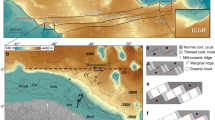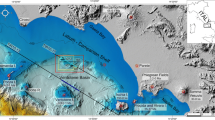Abstract
An interpretation of bathymetric and magnetic data obtained aboard the R/V Marion Dufresne provides us with new information concerning the evolution of the Southwest Indian Ridge, in the region of the Atlantis II Fracture Zone (57° E), since 10 Ma. On all profiles, the ridge axis and the axial magnetic anomaly have been clearly recognized. Bathymetric data illustrate the rapid variation of depth along the axis. On the western side of the ‘Atlantis II’ Fracture Zone, the along axis profile is characterized by a succession of two highs, and an important depression between them.
Our data show a strong relationship between the regional axial depth, the steep-sidedness of the axial valley and the signature of the central magnetic anomaly. In particular, where the axis is deepest (≃4500 m), there is a wide, shallow axial valley which is oblique to the spreading direction, and a non-typical central magnetic anomaly signature. In contrast, where the regional axial depth is shallow (≃3500 m), the axial valley is deep, narrow, perpendicular to the spreading direction, and the central magnetic anomaly is high in amplitude. The ridge axis on the western side of the Atlantis II Fracture Zone appears to consist of short segments located on the axial highs, which are linked by oblique zones. On the eastern side, the ridge axis is continuous, and appears to be oblique to the spreading direction.
Clearly lineated magnetic anomalies 3A (5 Ma) and 5 (10 Ma) have been identified and mapped. These magnetic data allow a reconstruction which shows an evolution of the axial geometry since 10 Ma. On the western side of the Atlantis II Fracture Zone, the axis at anomaly 5 time consisted of segments perpendicular to the spreading direction which were offset by transform faults. On the eastern side, the isochron A5 appears to be parallel to the present-day ridge axis. From this plate reconstruction, a spreading direction of 357° was deduced, and appears to be parallel to the Atlantis II Fracture Zone.
On each flank of the Suuthwest Indian Ridge, our bathymetric data show elongated ridges, aligned in a north-south direction, which correlate with the axial topographic highs. This direction is not precisely parallel to the spreading direction deduced from plate reconstruction. The differences in these directions suggest that transverse relief on show spreading ridge flanks (which could be interpreted as indicating the location of minor fracture zones) may not be indicative of the seafloor spreading direction.
Resumé
Cet article présente des données bathymétriques et magnétiques de la région axiale de la dorsale sud-ouest indienne au voisinage de la zone de fracture majeure ’Atlantis II’. Elles proviennent pricipalement de la campagne MD34 (Marion-Dufresne, 1983).
L'axe de la dorsale est défini par la vallée et l'anomalie magnétique qui lui est associée. Le rilief le long de l'axe varie localement très rapidement; A l'ouest de la zone de fracture ‘Atlantis II’, le plancher axial présente deux bombements séparés par une dépression importante (4600 m). Cette étude met en évidence la corrélation entre ces hauts bathymétriques, la forme de la vallée et la l'amplitude de l'anomalie magnétique axiale: lorsque la profondeur du plancher axial diminue, la vallée se creuse et son encaissement augmente. On observe ainsi sur les hauts bathymétriques une section d'axe très encaissée, associée à une anomalie magnétique d'amplitude plus importance.
L'identification de l'anomalie 5 (10 Ma) sur chaque flanc de la dorsale sud-ouest indienne permet la reconstitution de cette isochrone qui montre clairement une évolution de la géométrie de l'axe: à l'époque de l'anomalie 5, l'axe était composé de segments perpendiculaires à la direction d'expansion, décalés par des failles transformantes, alors qu'il apparait actuellement continu et formé sur les hauts topographiques de courts segments perpendiculaires à la direction d'expansion (et dans les dépressions par des sections d'axe très obliques).
La carte bathymétrique met en évidence des lignes de crêtes grossièrement Nord-Sud (007°) dont la direction diffère de la direction d'expansion (357°) déduite des reconstructions, et parallèle à la zone de fracture majeure ‘Atlantis II’. Sur les dorsales lentes, les zones de fractures mineures, n'indiqueraient donc pas la véritable direction d'expansion.
Similar content being viewed by others
Bibliographie
AtwaterT. and MacdonaldK. C., 1977, Are Spreading Centers Perpendicular to Their Transform Fault?, Nature 270, 715–721.
BerghH. W., 1971, Sea-floor Spreading in the Southwest Indian Ocean, J. Geophys. Res. 76, 6276–6282.
ChoukrouneP., FrancheteauJ., and HekinianR., 1984, Tectonics of the East Pacific Rise near 12°50′ N, a Submersible Study, Earth Planet. Sci. Lett. 68, 115–127.
ColletteB. J., SlootwegA. P., and TwigtW., 1978, Mid-Atlantic Ridge Crest Topography Between 12° and 15° N, Earth Planet. Sci. Lett. 42, 103–108.
CraneK., 1979, The Galapagos Rift at 86° W: Morphological Wave Forms; Evidence for a Propagating Rift, J. Geophys. Res. 84, 6011–6018.
CHAMEX Scientific Team, 1981, First Manned Submersible Dives on the East Pacific Rise at 21° N (Project RITA): General Results, Mar. Geophys. Res. 4, 345–379.
Daudin, J. Y., 1985, Exploitation des données de la campagne MD34; Interprétation des anomalies magnétiques d'une zone de la dorsale ouest-indienne, Rapport de stage de D.E.A. de géophysique Interne, Université Paris VII, pp. 79.
FisherR. L., JanischM. Z., and CimesR. L., 1982, General Bathymetric Chart of the Oceans (GEBCO), Canadian Hydrographic Service, Ottawa, Canada.
FisherR. L. and SclaterG., 1983, Tectonic Evolution of the Southwest Indian Ocean Since the Mid-Cretaceous: Plate Motions and Stability of the Pole of Antarctica/Africa for at Least 80 Myr, Geophys. J. Roy. Astron. Soc. 73, 553–576.
FrancheteauJ. and BallardR. D., 1983, The East Pacific Rise near 21° N and 20° S: Inferences for Along-strike Variability of Axial Processes of the Mid-Ocean Ridge, Earth Planet. Sci. Lett. 64, 93–116.
GreenwaltD. and TaylorP. T., 1974, Deep-tow Magnetic Measurements Across the Axial Valley of the Mid-Atlantic Ridge, J. Geophys. Res. 79, 4401–4405.
KlitgordK. D., 1975, Seafloor Spreading: The Central Anomaly Magnetization High, Earth Planet. Sci. Lett. 29, 201–209.
LachenbruchA. H., 1973, A Simple Mechanical Model for Oceanic Spreading Centers, J. Geophys. Res. 78, 3395–3417.
LeDouaranS. and FrancheteauJ., 1981, Axial Depth Anomalies from 10° to 50° North Along the Mid-Atlantic Ridge: Correlation with other Mantle Properties, Earth Planet. Sci. Lett. 54, 29–47.
LeDouranS., NeedhamH. D., and FrancheteauJ., 1982, Pattern of Opening Reates Along the Axis of the Mid-Atlantic Ridge, Nature 300, 254–258.
MacdonaldK. C., 1977, Near Bottom Magnetic Anomalies, Asymmetric Spreading, Oblique Spreading and Tectonics of the Mid-Atlantic Ridge near 37° N, Geol. Soc. Am. Bull 88, 541.
MinsterJ. B. and JordanT. H., 1978, Present-day Plate Motions, J. Geophys. Res. 83, 5331–5354.
NeedhamH.P. and FrancheteauJ., 1974, Some Characteristics of the Rift Valley in the Atlantic Ocean Near 36°48′ North, Earth Planet. Sci. Lett. 22, 29–43.
NelsonK. D., 1981, A Simple Thermal-Mechanical Model for Mid-ocean Ridge Topographic Variation, Geophys. J. Roy. Astr. Soc. 65, 19–30.
ParsonsB. and SclaterJ. G., 1977, An Analysis of the Variation of Ocean Floor Bathymetry and Heat Flow with Age, J. Geophys. Res. 82, 803–827.
Patriat, Ph., 1983, Evolution du système de dorsales de l'Océan Indien, Thèse d'Etat. Université Pierre et Marie Curie, pp. 308.
PatriatPh. and CourtillotV., 1984, On the Stability of Triple Functions and its Relation to Episodicity in Spreading, Tectonics 3, 317–332.
PatriatPh., SegoufinJ., GoslinJ., and BeuzartP., 1985, Relative Positions of Africa and Antarctica in the Upper Cretaceous: Evidence for Non-stationary Behaviour of Fracture Zones, Earth Planet. Sci. Lett. 75, 204–214.
RambergI. B., GrayD. F., and RaynoldsR. G. M., 1977, Techtonic Evolution of the Famous Area of the Mid-Atlantic Ridge, Lat. 35°50′ to 37°20′ N, Geol. Soc. Amer. Bull. 88, 609–620.
SchlichR. et PatriatPh., 1971, Mise en évidence d'anomalies magnétiques axiales sur la branche ouest de la dorsale médioindienne, C.R. Acad. Sc. Paris 272(D), 700–703.
SchoutenM. and WhiteR. S., 1980, Zero Offset Fracture Zone, Geology, 8, 175–179.
SchoutenH., KligordK. D., and WhiteheadJ. A., 1985, Segmentation of Mid-Ocean Ridges, Nature 317, 225–229.
SclaterJ. G., BowinC., HeyR., HoskinsH., PeirceJ., PhillipsJ., and TapscottC., 1976, The Bouvet Triple Junction, J. Geophys. Res. 81, 1857–1869.
SclaterJ. G., FisherR. L., PatriatPh., TapscottC., and ParsonsB., 1981, Eocene to Recent Development of the South West Indian Ridge, a Consequence of the Evolution of the Indian Ocean Triple Junction, Geophys. J. Roy. Astr. Soc. 64, 587–604.
SearleR. C. and LaughtonS., 1977, Sonar studies of the Mid-At-lantic Ridge and Kurchatov Fracture Zone, J. Geophys. Res. 82, 5313–5328.
SempereJ. C. and MacdonaldK. C., 1986, Overlapping Spreading Centers: Implications from Crack Growth Simulation by the Displacement Discontinuity Method, Tectonics 5, 151–163.
TapponnierP. and FrancheteauJ., 1978, Necking of the Lithosphere and the Mechanics of Slowly Accreting Plate Boundaries, J. Geophys. Res. 83, 3955–3970.
TapscottC. R., PatriatPh., FisherR. L., SclaterJ. G., HoskinsH., and ParsonsB., 1980, The Indian Ocean Triple Junction, J. Geophys. Res. 85, 4723–4739.
TisseauJ. and PatriatPh., 1981, Identifications des anomalies magnétiques sur les dorsales à faible taux d'expansion: méthode des taux ficits, Earth Planet. Sci. Lett. 52, 381–396.
WhiteheadJ. A., DickH. J. B., and SchoutenH., 1984, A Mechanism for Magmatic Accretion under Spreading Centres, Nature 312, 146–148.
Author information
Authors and Affiliations
Rights and permissions
About this article
Cite this article
de Ribet, B., Patriat, P. La région axiale de la dorsale sud-ouest indienne entre 53° est et 59° est: Son evolution depuis 10 Ma. Mar Geophys Res 10, 139–156 (1988). https://doi.org/10.1007/BF00310061
Received:
Revised:
Issue Date:
DOI: https://doi.org/10.1007/BF00310061




